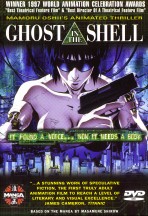
Released by: Columbia.
Region: One. (There has been a R4 release as well.)
Aspect Ratio:16:9 (anamorphic)
Disc 1:
When the line between man and machine is blurred by the perfection and commonplace useage of cybernetics then we have the potential for revolution. Ghost in the Shell, obviously a post net tale in conception, shows a highly interconnected world where information is the corner stone of power. To control, protect and enforce the flow of information in Japan Section 9 has been given the mandate and technology to handle domestic information crimes - be they hacking attempts, sale of critical information and the like.
The film opens with the heavily cybernetically enhanced Major Kusanagi helping foil the sale of information about a project another government department has been running and had comprimised - seemingly as part of the activites of the master hacker the 'Puppet Master'. From here the film follows the section's efforts to foil this hacker who has been systematically interferring in global politics.
You might be excused in thinking that this is purely a political thriller and politics do indeed play a large part of the plot. But like Blade Runner the core of the story is really the musing on what constitutes human existance and it's future. The Major is already struggling with this problem in a body that is almost entirely artifical and yet she feels human because of her memories of being so. However memories can be tampered with so in a world where even your own memories can not be trusted how do you maintain a sense of self?
Of course this is thriller enough to maintain several set pieces of high intensity action that are cleverly and realisticly handled. For the detail junkies watch the Major as she passes through the market in pursuit while cloaked. The animators have gone to the trouble of remembering to leave her shadow in the scene as well as details like her extreme weight, being mostly cyborg. (The cloaking works by having a layer of light senstive material note what the world looks like on the other side of you and then mimicing that pattern on the opposite side. Effectively a dynamic camoflauge that always matches what you are standing in front of.)
Indeed part of the power of this film is in the detail work and the heavy use of computer imagery powers this. Guns produce recoil and require reloading, shadows are where they should be, weight and momentum are accounted for and water ripples & reflects. One of the strongest images in the film is that of the major watching the sky through water as she floats to the surface (with the aid of floatation devices. :) ) that relies heavily on computer work. All this adds veritas to a tale that otherwise would come across as too pretentious.
Instead it manages to walk a fine line between too fantastic and eminently plausible. The animation is mostly fluid and extremely well done which gives the action sequences an almost balletic grace. Helping greatly with the mood is a strong soundtrack that captures a floating and slightly uneasy feeling. Voice dubbing is excellent as well along with suitably impressive booms, thuds and crashes as the various guns wreak havoc.
If it weren't for the slightly laboured symbology towards the end and jarring monologues that crop up the film would be pretty much perfect. The monologues in particular suffer as they don't quite gell with the Major as a character - for effectively a special forces agent who enjoys the down and dirty work she seems abruptly contemplative. A little more character establishment near the begining would have eased this but instead the opening is a high octane action piece.
Especially given the character has every reason to be contemplative - her body augmentations give her good motivation. We just needed a little more work early on to show this. It's an intelligent film that rewards both the viewers who want a deep contemplative plot and yet still have high energy action. Anime doesn't get much better than this.

Released by: Madman.
Region: Four.
Aspect Ratio:16:9 (anamorphic)
Disc 1:

After a number of years the venerable Ghost in the Shell film has been re-released, neatly coinciding with the release of it's sequel to theatres. It is interesting returning to this film after such a long time to see how well it holds up compared to modern releases. Remarkably well is the answer, especially given the tidying up the film has been given for it's re-release.
First off is the packaging. As you can see I've included two images for the re-release, the first one is of the DVD cover itself. The second is of the fetching slip case the DVD lives in. Absolutely no point to this slip case - no room is made for the sequel to live in it. It merely provides a nice tactile experience as you slide the movie out to view it. Similarly the DVD cover itself has been reworked to a similar visual style as the original but with a white theme to match the new slip case. I believe it echoes the style of some of the production posters made for the films original theatrical release.
Packaging aside, the DVD itself comes with two major new features - the reworking of the film soundtracks and a new featurette on the making of the film. Specificly this concentrates on the development of the computer imaging techniques used in the film. Most interesting are the snippets of Mamoru Oshii himself explaining precisely what the new techniques let him accomplish. The featurettes are all 4:3 affairs with Japanese audio and english subtitles obviously made for use in various TV promotional spots.
Which leaves us with the film itself. As already mentioned the soundtracks have been worked over. The English track becomes a 5.1 EX track (effectively 6.1) but of all the tracks changers the least from its previous incarnation. The Japanese tracks are the biggest change with us finally having full 5.1 audio and in extra special pleasure for the audio enthusiasts is the DTS track. Part of the reworking has been a tidying of the soundscape and to my ears a smidgen more directionality included in a sountrack that is still fairly strongly front centred.
Visually it is harder to discern an obvious difference. Yes the film has been tidied up and is looking very good. But compared to previous releases of the film this is more a small evolutionary change, if you own a copy of the film already don't expect a radicly different experience here. I've provided a Region Four and a Region One frame capture from the two versions for comparison. I've tried to match frames exactly but the timings on the two versions are slightly different so I've come close but not identical. Both are anamorphic prints and you can see the differences easily. The R1 release is a smidgen more edge defined but lacking in detail. The R4 is a touch softer but the extra resolution is providing more detail to view. In terms of the viewing experience on the screen, the new version is noticeably better on a PAL TV.
Perhaps most disappointingly about the new release is that it clearly isn't a new master from a telecine. Both versions share the exact same telecine wobble. Clearly it is a digital tidying of the existing source material and re-encoded onto a R4 disc using better encoding techniques. It is being a little picky to criticise on this as, given the Australasian anime market size, the cost involved in doing a completely new master for Madman would be impossible. But still... it would have been nice.
All in all though I am very happy to be double dipping on this film. It still is a visually arresting and well done film that compares very well to modern releases. For those who haven't got the film already or who favour the Japanese audio tracks then this is an excellent release well worth adding to any collection.